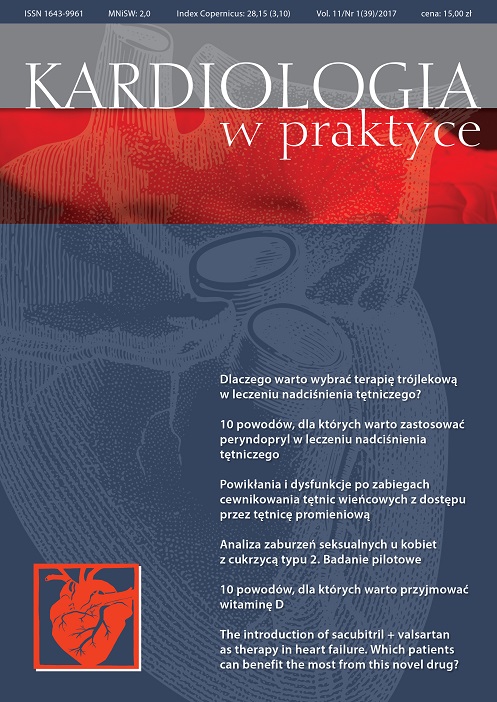10 powodów, dla których warto przyjmować witaminę D Artykuł przeglądowy
##plugins.themes.bootstrap3.article.main##
Abstrakt
Witamina D należy do grupy witamin rozpuszczalnych w tłuszczach. Jej najbardziej znaną funkcją jest ułatwianie wchłaniania wapnia i fosforanów w jelitach. Razem z parathormonem i kalcytoniną reguluje metabolizm kostny i utrzymuje stałe stężenie wapnia w surowicy krwi. Odkryta została ponad 100 lat temu, jednak dopiero w latach 30. ubiegłego stulecia powiązano jej niedobór z występowaniem krzywicy. Badania z drugiej połowy XX w. wykazały, że w istocie witamina D jest prohormonem, który dopiero po przekształceniu przejawia aktywność, łącząc się ze swoistym receptorem (VDR). W ostatnich latach nastąpił olbrzymi wzrost zainteresowania koncepcją uznającą witaminę D jako hormon o działaniu plejotropowym. W licznych badaniach sugeruje się istotną rolę jej niedoboru jako czynnika ryzyka nie tylko krzywicy i osteomalacji, ale też chorób sercowo-naczyniowych, autoimmunologicznych, zakażeń, nowotworów, cukrzycy, a nawet depresji. W świetle tych badań wydaje się zasadna suplementacja witaminą D, szczególnie w okresie jesienno-zimowym.
Pobrania
##plugins.themes.bootstrap3.article.details##

Utwór dostępny jest na licencji Creative Commons Uznanie autorstwa – Użycie niekomercyjne 4.0 Międzynarodowe.
Copyright: © Medical Education sp. z o.o. This is an Open Access article distributed under the terms of the Attribution-NonCommercial 4.0 International (CC BY-NC 4.0). License (https://creativecommons.org/licenses/by-nc/4.0/), allowing third parties to copy and redistribute the material in any medium or format and to remix, transform, and build upon the material, provided the original work is properly cited and states its license.
Address reprint requests to: Medical Education, Marcin Kuźma (marcin.kuzma@mededu.pl)
Bibliografia
2. Płudowski P., Konstantynowicz J., Jaworski M. et al.: Ocena stanu zaopatrzenia w witaminę D w populacji osób dorosłych w Polsce. Standardy medyczne/ Pediatria 2014; 11: 609-617.
3. Płudowski P., Grant W.B., Bhattoa H.P. et al.: Vitamin status in Central Europe. Int. J. Endocrinol. 2014. http://doi.org/10.1135/2014/589587.
4. Płudowski P., Karczmarewicz E., Chlebna-Sokół D. et al.: Witamina D: Rekomendacje dawkowania w populacji osób zdrowych oraz w grupach ryzyka deficytów – wytyczne dla Europy Środkowej 2013 r. Standardy medyczne/Pediatria 2013; 10: 573-578.
5. Lips P.: Vitamin D physiology. Prog. Biophys. Mol. Biol. 2006; 92: 4-8.
6. Lai Y.-H., Fang T.-C.: The pleiotropic effect of vitamin D. ISRN Nephrology 2013. http:/doi.org/10.5402/2013/898125.
7. Bikle D.D.: Vitamin D metabolism, mechanism of action, and clinical applications. Chem. Biol. 2014; 21(3): 319-329. http://doi.org/10.1016/j.chembiol.2013.12.016.
8. Wacker M., Holick M.: Vitamin D-effects on skeletal and extraskeletal health and the need for supplementation. Nutrients 2013; 5: 111-148. http://doi.org/10.3390/nu5010111.
9. Baeke F.,Takishi T., Korf H. et al.: Vitamin D: modulator of the immune system. Curr. Opin. Pharmacol. 2010; 10: 482-496.
10. Van Belle T.L., Gysemans C., Mathieu C.: Vitamin D in autoimmune, infections and allergic diseases: A vital player? Best Pract. Res. Clin. Endocrinol. Metab. 2011; 25: 617-632.
11. Bergman P., Lindh A.U., Björkhem-Bergman L., Lindh J.D.: Vitamin D and respiratory tract infections: A systematic review and meta-analysis of randomized controlled trials. PloS one 2013; 8(6): e65835. http://doi.org/10.1371/journal.pone 0065835.
12. Pelajo C.F., Lopez-Benitez J.M., Miller L.C.: Vitamin D and autoimmune rheumatic disorders. Autoimmun. Rev. 2010; 9: 507-510.
13. Pierrot-Deseilligny C., Rivaud-Pechoux S., Clerson P. et al.: Relationship between 25-OH-D serum level and relapse rate in multiple sclerosis patients before and after vitamin D supplementation. Ther. Adv. Neurol. Disord. 2012; 5: 187-198.
14. Sǿrensen I.M., Joner G., Jenum P.A. et al.: Maternal serum levels of 25-hydroxy-vitamin D during pregnancy and risk of type 1 diabetes in the offspring. Diabetes 2012; 61: 175-178.
15. Autier P., Boniol M., Pizot C., Mullie P.: Vitamin D status and ill health: a systematic review. Lancet Diabetes Endocrinol. 2014; 2(1): 76-89.
16. Norman P.E., Powell J.T.: Vitamin D and cardiovascular disease. Circulation research 2014; 114: 379-393.
17. Kosecik M., Ertas T.: Dilated cardiomyopathy due to nutritional vitamin deficiency rickets. Pediatr. Int. 2007; 49: 397-399.
18. Nimiphong H., Holick M.F.: Vitamin D, neurocognitive functioning and immunocompetence. Curr. Opin. Clin. Nutr. Metab. Care 2010; 14: 7-14.
19. Schlögl M., Holick M.F.: Vitamin D and neurocognitive function. Clin. Interv. Aging 2014; 9: 559-568.
20. Chowdhury R., Kunutsor S., Vitezova A. et al.: Vitamin D and risk of cause specific death: systematic review and meta-analysis of observational cohort and randomised intervention studies. BMJ 2014. http://doi.org/101136/bmj.g1903.
21. Amrein K., Schnedl C., Holl A. et al.: Effect of high-dose vitamin D3 on hospital length of stay in critically ill patients with vitamin D deficiency. The VITdAL-ICU Randomized clinical trial. JAMA 2014; 312: 1520-1530.
